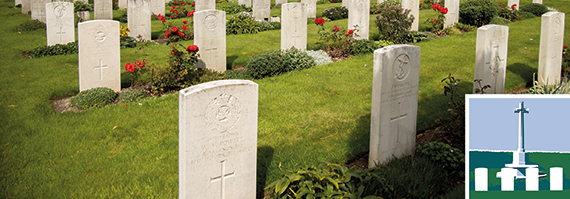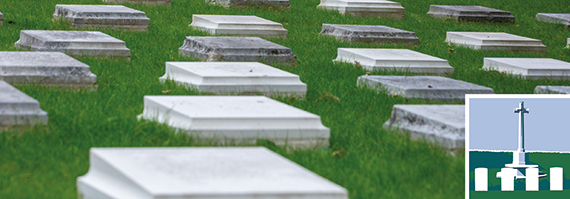Pembroke Dock Military Cemetery
Now an island of old Pembroke Dock’s past surrounded by modern housing developments, discover the only military cemetery in Wales. Owned by the MOD but cared for by the CWGC, come and visit a century’s graves of men of the army, navy and air force. Forty are First World War graves, while 33 were buried here between 1939-1947.
![]()
Burials began in Pembroke Dock Military War Cemetery in the 1860s and continued until the 1960s when the military presence in the town ended. Over 160 servicemen were laid to rest here during that century, along with 23 service dependants – wives and children of men of the garrison or naval dockyard. During the First World War, forty servicemen were buried here, all of them members of army units posted to the area for home defence or training: units like the Royal Garrison Artillery and Ordnance Corps, and six different infantry regiments. Like other troops stationed in the UK they died of disease or in accidents.
The Second World War saw conflict reach out and touch Pembroke Dock more directly. German bombers raided the area more than once, and a terrible accident during a training exercise caused 17 servicemen to be buried here on a single day. The crash of a bomber on a training mission left five Australian aircrew here, far from home, but remembered by the community every Anzac Day.
Find out more about the history of this cemetery
A small Welsh fishing village became the town of Pembroke Dock after the Royal Navy built a dockyard there in 1814. The need to defend the dockyard and naval base meant that Pembroke Dock became a military town. Defensible barracks and Martello towers were built and artillerymen, Royal Marines and army regiments garrisoned these. Purpose-built barrack blocks to house up to a thousand men were built at Llanion in 1904. Troops would live and serve in the area until 1967.
August 1914 found the 2nd Battalion of the Border Regiment taking their turn in the garrison of Milford Haven, living in Llanion Barracks. Within a month of the outbreak of war they were hurried off to the Western Front, landing in Belgium on 6 October 1914. They left behind two of their number who died in the fourth week of the war – the first two war graves of the First World War in this cemetery. Robert Handel Mendelson Griffiths, a boy soldier who served as a musician in the regiment, died 29 August 1914. During this era, British infantry regiments were allowed to enlist those aged 14-17 as musicians – often buglers or trumpeters – with parental permission. Robert Griffiths died at Lamphey Siding, about four miles southeast of Pembroke Dock, in a railway incident. A fellow boy soldier, James O’Brien, seriously injured in the same incident, died three days later, joining Robert in the military cemetery.


Border Regiment and KSLI headstone badges drawings © CWGC
These two young servicemen would be joined by 12 men of the King’s Shropshire Light Infantry from September 1914 to January 1916 while they served in the area. The 3rd Battalion of The King’s (Liverpool Regiment) spent most of 1915-1917 here, laying to rest six of their men during that time, including Private Henry Bascombe, born in San Fernando, Trinidad. Henry had made his own way to England in order to enlist. He fought on the western front and had been recommended for a medal. While posted to Pembroke Dock, he was out cycling when hit by a motor lorry.

A Sunderland over Milford Haven, August 1941. © AWM SUK15112
The naval dockyard closed in 1926, but in 1931 the Royal Air Force arrived, establishing RAF Pembroke Dock with squadrons operating flying boats. During the war, it was the largest operational flying boat base in the world. Coastal Command squadrons operating flying boats like Short Sunderlands performed air sea rescues, convoy escort duties and anti-submarine warfare. Many Coastal Command dead are named on the Runnymede Memorial because they went missing on operations over water. For all the squadrons that fought the war from Pembroke Dock, only two Coastal Command men are buried here. Both flew with No. 461 Squadron, Royal Australian Air Force. Both were in Sunderlands that were attacked by multiple German aircraft at once but managed to reach British shores, bringing home their wounded and dead.

A downed bomber crew get onboard their rescuing Sunderland from a Pembroke Dock-based squadron. © AWM SUK10482
Facilities around Milford Haven were targets for German bombers. On 19 August 1940, oil tanks at Pennar were bombed and the fire that followed raged for 18 days. In 1941, on 11-12 May, bombers struck Pembroke Dock, killing 35 civilians. The CWGC remembers them by name on our Civilian Roll of Honour in Westminster Abbey. Bombers returned in June, but fortunately far fewer were killed that night.
The worst military loss of the war in this corner of Wales occurred on 28 April 1942. A group of soldiers from the Pioneer Corps and the King’s Own Scottish Borderers were being trained in the disposal of land mines by bomb disposal experts of the Royal Engineers. Something went wrong and the ensuing explosion killed 18 men instantly. Seventeen are buried together here. Two were German Jewish refugees who had escaped from Nazi Germany.

Temporary cross marking the grave of air gunner Fl Sgt Woolhouse of Perth, Western Australia, in Pembroke Dock Military Cemetery. Based at RAF Pembroke Dock, he was killed onboard his Sunderland during an anti-submarine patrol when they were attacked repeatedly by a formation of six German aircraft. His pilot got them back as far as the Scilly Islands where they made an emergency landing. The survivors and Woolhouse were returned to Pembroke Dock where he was buried. You can see the Star of David markers for Private Schwartze and Corporal Abraham, killed in the 28 April 1942 incident, behind Woolhouse’s cross. © AWM P03816.001
Visit Pembroke Dock Military Cemetery
Access to Pembroke Dock Military Cemetery is by foot from Canterbury Road.

Opened in 1859, this is the final resting place of over 700 Commonwealth and Allied servicemen and women of the two world wars.
Cardiff Cathays Cemetery
Amongst the many thousands of civilian burials here are 254 Commonwealth War Graves, 158 from the First World War and 96 from the Second.
Gloucester Old Cemetery
This example of a grand Victorian garden cemetery is where the CWGC commemorates more war dead than anywhere else in Bristol. Many were buried by their next of kin, but others are far from home indeed
Bristol (Arnos Vale) Cemetery
Visit the largest group of war graves in this part of Mid Wales. Thirteen servicemen of the First World War and eleven of the Second lie here, most of them under the familiar CWGC pattern headstone.
Brecon Cemetery




